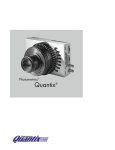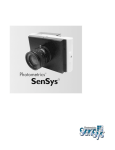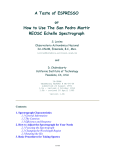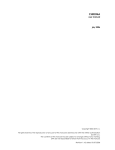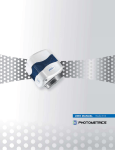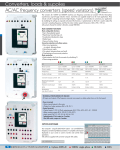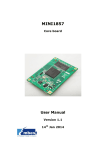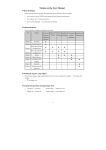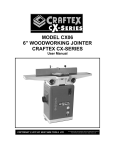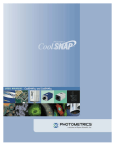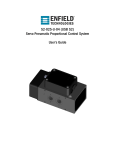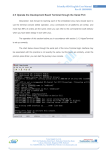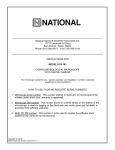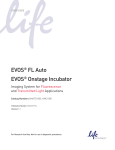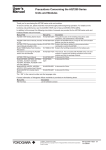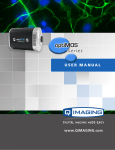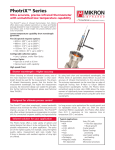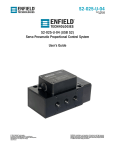Download sensys operating manual
Transcript
, SenSys ™ User Manual SenSys™ User Manual © Copyright 1998 Photometrics Ltd. 3440 East Britannia Drive Tucson, Arizona 85706 TEL: 520/889–9933 FAX: 520/295-0299 All rights reserved. No part of this publication may be reproduced by any means without the written permission of Photometrics Ltd. Printed in the United States of America. US Patents 5,594,520 and 5,393,931 Metachrome and PVCAM are registered trademarks of Photometrics Ltd. CAMTEST, PPD, and SenSys are trademarks of Photometrics Ltd. Nikon is a registered trademark of Nikon Corporation. Other brand and product names are the trademarks or registered trademarks of their respective owners and manufacturers. The information in this publication is believed to be accurate as of the publication release date. However, Photometrics Ltd. does not assume any responsibility for any consequences including any damages resulting from the use thereof. The information contained herein is subject to change without notice. Revision of this publication may be issued to incorporate such change. Warning: This is a Class A product. In a domestic environment this product may cause radio interference in which case the user may be required to take adequate measures. Camera System Warranty (excluding software) Photometrics Ltd. warrants that its products are free of defects in material and workmanship. The period over which Photometrics’ products are warranted is twelve (12) months from the date of shipment listed on the packing slip shipped with the equipment. Photometrics will repair or replace the product if it is found to be defective within the warranty period. Photometrics must be notified in writing of the defect within the warranty period. The affected product should be returned to Photometrics within thirty (30) days after discovery of such defect. Shipment should not be made without prior authorization by Photometrics. When products are returned to Photometrics for warranty service, the buyer shall prepay shipping charges to Photometrics and Photometrics shall pay shipping charges to return the product to the buyer. The buyer shall pay all shipping charges, duties, and taxes for products returned to Photometrics from outside the U.S.A. This warranty does not apply to defects resulting from improper or inadequate maintenance by the buyer, buyer-supplied software or interfacing, unauthorized modification or misuse, or improper site preparation or maintenance. Photometrics’ liability shall not exceed the cost of repair or replacement of the defective equipment. This warranty becomes void if the user attempts to repair or modify the product without the written consent of Photometrics. Except for removing the shutter cover, this warranty is voided if the user opens the camera head. Metachrome® II Warranty Photometrics Ltd. warrants that the Metachrome II coating will maintain 95% of initial quantum efficiency without the need to pre-flash. This warranty is not affected by high UV exposure levels. The period over which Metachrome II coating is warranted is twenty-four (24) months from the date of shipment listed on the packing slip shipped with the equipment. Photometrics will recoat the CCD at no cost if quantum efficiency drops below 95% of initial performance within the warranty period. Photometrics must be notified in writing of the defect within the warranty period. The affected camera system should be returned to Photometrics within thirty (30) days after discovery of such defect. Shipment should not be made without prior authorization by Photometrics. The buyer shall prepay shipping charges to Photometrics and Photometrics shall pay shipping charges to return the product to the buyer for products returned to Photometrics for warranty service. The buyer shall pay all shipping charges, duties, and taxes for products returned to Photometrics from outside the U.S.A. This warranty does not apply if reduced quantum efficiency due to damage to the CCD or Metachrome II from unauthorized modification or use of the camera system. Photometrics’ liability shall not exceed the cost of repair or replacement of the defective equipment. This warranty becomes void if the user attempts to repair or modify the product without the written consent of Photometrics. This warranty is voided if the user opens the camera head. SenSys Sealed Chamber Integrity Warranty Photometrics Ltd. warrants the SenSys sealed chamber integrity for a period of twenty-four (24) months. The warranty period is from the date of shipment listed on the packing slip shipped with the equipment. Photometrics will repair or replace the camera system if it fails to maintain the sealed chamber integrity with proper use within the warranty period. Photometrics must be notified in writing of the defect within the warranty period. The affected camera system should be returned to Photometrics within thirty (30) days after discovery of such defect. Shipment should not be made without prior authorization by Photometrics. The buyer shall prepay shipping charges to Photometrics and Photometrics shall pay shipping charges to return the product to the buyer for products returned to Photometrics for warranty service. The buyer shall pay all shipping charges, duties, and taxes for products returned to Photometrics from outside the U.S.A. This warranty does not apply to defects resulting from improper or inadequate maintenance by the buyer, unauthorized modification or misuse, or improper site preparation or maintenance. Photometrics’ liability shall not exceed the cost of repair or replacement of the defective equipment. This warranty becomes void if the user attempts to repair or modify the product without the written consent of Photometrics. This warranty is voided if the user opens the camera head. Declaration of Conformity Photometrics, Ltd. declares that the equipment described in this document is in conformance with the requirements of the European Council Directives, listed below: 89/336/EEC EMC Directive 93/68/EEC EMC Directive 73/23/EEC Low Voltage Directive on the approximation of the laws of Member States relating to Electromagnetic Compatibility and Product Safety. This declaration is based upon compliance of the product to the following standards: EN 55022-A, CISPR 22 EN 50082-1, IEC 801 EN 60950, IEC 950 RF Emissions Control Immunity to Electromagnetic Disturbances Product Safety Product Description: CCD Camera System Model: SenSys Camera System Authorized Signature Wilhelm Pfanhauser Photometrics, Ltd. Sollner Str. 61 D-81479 München Germany Date 11/16/95 Table of Contents Chapter 1. Introduction SenSys System Components .................................................................................. 1 Standard Components....................................................................................... 1 Optional System Hardware .............................................................................. 1 About this Manual ................................................................................................... 2 Environmental Requirements ................................................................................ 2 Storage Requirements ............................................................................................. 2 Precautions................................................................................................................ 2 Repairs....................................................................................................................... 3 Cleaning .................................................................................................................... 3 Photometrics Customer Service............................................................................. 3 Chapter 2. Hardware Installation Connecting Mount Adapters, Tripod Mounts, and Other Instruments .......... 5 Connecting the AIA Cable...................................................................................... 5 Connecting the Power Brick................................................................................... 6 Chapter 3. Configuration Options Lens Mount Adapters ............................................................................................. 7 C-Mount Assembly............................................................................................ 8 F-Mount Assembly ............................................................................................ 9 Tripod Camera Stand ............................................................................................ 10 Chapter 4. Component Descriptions CCD.......................................................................................................................... 11 MPP .................................................................................................................... 11 Metachrome II................................................................................................... 12 Certificate of Calibration................................................................................. 12 Window................................................................................................................... 12 CCD Chamber ........................................................................................................ 12 Thermoelectric Cooler........................................................................................... 12 Shutter ..................................................................................................................... 12 Electronics ............................................................................................................... 13 Input/Output Trigger Port .................................................................................. 13 AIA Port .................................................................................................................. 14 Power Port .............................................................................................................. 14 Status Lights ........................................................................................................... 14 Power Brick............................................................................................................. 15 Mount Adapters..................................................................................................... 16 C-Mount ............................................................................................................ 17 F-Mount ............................................................................................................. 17 Lenses ...................................................................................................................... 17 Tripod Camera Stand ............................................................................................ 17 Chapter 5. Troubleshooting Green Light on Camera Does Not Illuminate.................................................... 19 Image is Fuzzy........................................................................................................ 19 Camera Does Not Respond to Light ................................................................... 19 Camera Shutter Needs Replacing.................................................................. 20 Camera Does Not Focus ....................................................................................... 22 Chapter 6. Specifications Camera .................................................................................................................... 23 F-Mount Camera.................................................................................................... 24 C-Mount Camera ................................................................................................... 25 F-Mount Adapter ................................................................................................... 26 C-Mount Adapter .................................................................................................. 27 Power Brick............................................................................................................. 28 Input/Output Port Pinout.................................................................................... 29 Power Port Pinout.................................................................................................. 31 AIA Cable Pinout................................................................................................... 32 CCD Orientation .................................................................................................... 33 CCD Specifications ................................................................................................ 34 KAF 0400 ........................................................................................................... 34 KAF 1400 ........................................................................................................... 35 KAF 1600 ........................................................................................................... 36 Index .....................................................................................................................37 SenSys User Manual Chapter 1. Introduction SenSys™ is an air-cooled camera system with the ability to acquire low-light images by integrating (exposing) over long periods of time. The imager in the camera is a scientific-grade charge-coupled device (CCD). SenSys System Components All SenSys systems consist of standard hardware and software as well as the appropriate interface hardware (discussed in the Software Guide) for your computer system. Some SenSys systems also include optional hardware. Standard Components Power Brick Air-Cooled Camera Host Connectivity Kit Diskette AIA Cable Optional System Hardware Lenses Tripod 1 About this Manual The SenSys User Manual is divided into six chapters. It is suggested that you read the entire manual before operating the camera to ensure proper usage. The chapters that follow this introduction are • Hardware Installation — Instructions for connecting the camera to mount adapters, tripod mounts, and other instruments, as well as for connecting it to the AIA cable and the power brick • Configuration Options — Instructions for changing mount adapters, lenses, and tripod stands • Component Descriptions — Functional description of each component • Troubleshooting — Answers to camera hardware problems • Specifications — Specifications for each camera system component Note: To install a new camera, begin with the Hardware Installation chapter in this User Manual and then proceed to the Software Guide. Environmental Requirements The SenSys camera system should be operated in a clean, dry environment. The camera system requires that an easily accessible electrical outlet be available near the equipment. The camera system’s ambient operating temperature is 0˚C to 40˚C. The camera can be operated in any orientation, therefore it can be used on a tripod camera stand or mounted on a variety of instruments. Storage Requirements Precautions Store the SenSys camera system in its original containers. To protect the system from excessive heat, cold, and moisture, store at an ambient temperature between -20˚C and 60˚C with a relative humidity of 0%–90% noncondensing. The CCD and other system electronics are extremely sensitive to electrostatic discharge (ESD). To avoid permanently damaging the system, please observe the following precautions: • If you are using high-voltage equipment (such as an arc lamp) with your camera system, be sure to turn the camera power on last and power the camera off first. • Always switch off and unplug the power supply before changing your system configuration in any way. • Use caution when triggering high-current switching devices (such as an arc lamp) near your system. The CCD can be permanently damaged by transient voltage spikes. If electrically noisy devices are present, an isolated, conditioned power line or dedicated isolation transformer is highly recommended. • Never connect or disconnect any cable while the camera system is powered on. Reconnecting a charged cable may damage the CCD. • Never impede airflow through the equipment by obstructing the air vents. 2 SenSys User Manual Repairs Cleaning Photometrics Customer Service Repairs must be done by Photometrics. Should your system hardware need repair, contact Photometrics Customer Service. Please save the original packing materials so you can safely ship the camera system to another location or return it for repairs if necessary. Clean exterior surfaces of the camera system with a dry, lint-free cloth. To remove stains, contact Photometrics Customer Service. If you have any questions, contact Photometrics Customer Service. When you call, please have your Photometrics job number or equipment serial numbers available. • Phone: 520/889-9933 between 7 am and 5 pm MST • Fax: 520/295-0299 • E-mail: [email protected] • Mail: Photometrics Ltd. 3440 East Britannia Drive Tucson, Arizona 85706 In Europe, you can reach Customer Service at: • Phone: 089/79 95 80 between 9 am and 5 pm • Fax: 089/ 79 97 15 • Mail: Photometrics GmbH Sollner Str. 61 D-81479 München, Germany General information and answers to some customer service questions may be found on our Web site: http://www.photomet.com Chapter 1. Introduction 3 4 SenSys User Manual Chapter 2. Hardware Installation Hardware installation includes: • Connecting the camera to mount adapters, tripod mounts, and other instruments • Connecting the camera to the AIA cable • Connecting the camera to the power brick Connecting Mount Adapters, Tripod Mounts, and Other Instruments The camera is shipped with a removable F- or C-mount adapter attached. If applicable, change the mount adapter or attach a compatible lens. For information on changing the mount adapter, installing a compatible lens, or installing a standard tripod camera stand, see Chapter 3. Configuration Options. A C-mount lens with optics that protrude a long distance into the camera may interfere with the shutter blades. Specifications for calculating acceptable flange focal distances are located on page 27. If applicable, mount the camera on a compatible instrument or connect your own trigger equipment to the 9-pin, female input/output (I/O) trigger port located on the back of the camera. If you are using high-voltage equipment (such as an arc lamp) with your camera system, be sure to turn the camera power on last and power the camera off first. For trigger port pin-out specifications, see page 29. Connecting the AIA Cable • If your system’s AIA cable has a wide end and a narrow end, connect the wide end of the cable to the camera’s AIA port (see the diagram on page 14). • If your system’s AIA cable has matching ends, connect either end of the AIA cable to the camera’s AIA port (see the diagram on page 14). Make sure to use the AIA cable that was shipped with your system. You will be connecting the other end of the AIA cable to your interface hardware. For the moment, simply leave the other end of the AIA cable unattached. Instructions for installing interface hardware are provided in the Software Guide that was shipped with your camera. Refer to the Software Guide after completing the rest of this chapter. 5 Connecting the Power Brick The power brick is a switched supply that is shipped with a power supply cord. Caution: Connecting or removing a live power cable to or from the SenSys camera can damage the camera's electronic components. Do not attach or remove any cables while the power brick is switched on (On = |, Off = 0) and plugged into an electrical outlet. To connect the power brick to the camera: Power Brick Cable with 9-pin, D Connector 1. Connect the power brick cable's 9-pin, D connector to the power port on the back of the camera (see the diagram on page 14). Secure by tightening the connector screws. Do not extend this cable. 2. With the power brick switched off and the power cord unplugged from an electrical outlet, connect the power cord to the power brick (and later to an electrical outlet). Power Cord Power Off (0) Power Brick Cable Instructions for powering on and powering off the camera system are provided in the Software Guide. When you turn on your camera later (after installing the interface hardware), the red light on the camera illuminates immediately, indicating that the camera has power. In 20-40 seconds, the green light illuminates, indicating that the camera has reached operating temperature. See Status Lights on page 14 of this User Manual for more information. 6 SenSys User Manual Chapter 3. Configuration Options The SenSys hardware configuration options allow you to adapt your camera to standard scientific instruments and lenses. Removable F-mount and C-mount adapters, F-mount and C-mount lenses, and a tripod camera stand are available through Photometrics. Lens Mount Adapters SenSys cameras are shipped with a removable F-mount adapter or C-mount adapter installed. The F-mount adapter allows the camera to be attached to lenses and scientific instruments that are compatible with a Nikon® bayonet mount. The C-mount adapter allows the camera to be attached to many video camera lenses and C-mount-compatible scientific instruments. The F-mount adapter is secured with two #6-32 socket set screws; the C-mount adapter is secured with two #4-40 socket set screws. C-Mount Adapter F-Mount Adapter C-Mount Lens (optional) F-Mount Lens (optional) SenSys Mount Options 7 C-Mount Assembly The C-mount adapter is a standard threaded video mount with a standard C-mount flange focal distance and additional travel distance to allow parfocal adjustment with a variety of instruments. For specifications, see C-Mount Adapter on page 27. When the C-mount adapter is in place, a lens with optics that protrude a long distance into the camera may interfere with the shutter blades. To calculate appropriate measurements, refer to page 27. C-Mount Lens C-Mount Adapter C-Mount Cap C-mount Assembly To install the C-mount adapter (if not pre-installed): 1. Using the .050” hex wrench provided, back out the set screws so they do not interfere with threading the mount in place. There is no need to remove the set screws. 2. Thread the C-mount adapter onto the lens or instrument adapter. Lock in place using the .050” hex wrench provided. 3. Thread the C-mount adapter into the camera. (In certain cases, it may be easier to thread the camera onto the C-mount adapter.) To focus the camera: 1. If needed, back out the set screws until you can freely rotate the C-mount adapter. 2. Using the instructions from your software program, bring your software into focus loop mode. For instructions on using CAMTEST™ to focus, see the Focusing the Camera section of the CAMTEST chapter in the Software Guide. 3. Hold the camera so it does not rotate, then use the lens or instrument adapter to adjust the C-mount adapter to the desired position. 4. Tighten the set screws until snug. To remove the C-mount adapter: 1. Using the .050” hex wrench provided, back out the set screws until you can freely rotate the mount. 2. Unscrew the mount from the camera. 8 SenSys User Manual F-Mount Assembly The F-mount adapter is a standard Nikon bayonet mount with a standard F-mount flange focal distance and additional travel distance to allow parfocal adjustment with a variety of instruments. For specifications, see F-Mount Adapter on page 26. F-Mount Adapter Lens (optional) Lens Cap F-mount Assembly To install the F-mount adapter (if not pre-installed): 1. Using the 1/16” hex wrench provided, back out the set screws so they do not interfere with threading the mount in place. There is no need to remove the set screws. 2. Thread the F-mount adapter onto the camera. 3. Insert the lens into the adapter and rotate it counterclockwise to lock. If you don’t use a lens, simply attach your instrument’s F-mount adapter to the camera or attach the camera to the instrument’s F-mount. (If your instrument requires an F-mount adapter, contact your instrument supplier.) To focus the camera: 1. If needed, back out the set screws until you can freely rotate the F-mount adapter. 2. Using the instructions from your software program, bring your software into focus loop mode. For instructions on using CAMTEST™ to focus, see the Focusing the Camera section of the CAMTEST chapter in the Software Guide. 3. Hold the camera so it does not rotate, then rotate the F-mount adapter to the desired position. 4. Tighten the set screws until snug. To remove the F-mount adapter: 1. Using the 1/16” hex wrench provided, back out the set screws until you can freely rotate the mount. 2. Unscrew the mount from the camera. Chapter 3. Configuration Options 9 Tripod Camera Stand The SenSys camera has four mounting holes that are tapped for a standard tripod mounting bolt. Tripod Mounts on 4 sides (0.25"-20 UNC-2B) Camera with Tripod Camera Stand To mount the SenSys camera on a tripod camera stand: 1. Loosen the tripod mount locknut so that the maximum length of the tripod mounting bolt is exposed. 2. Align the camera on the tripod mounting bolt, using one of the four mounting holes on the camera body. 3. Thread the tripod mounting bolt into the camera body. 4. Tighten the locknut on the mount to secure the camera. To remove the SenSys camera from a tripod mount: 1. Loosen the tripod mount locknut. 2. Unthread the tripod mounting bolt from the camera. 10 SenSys User Manual Chapter 4. Component Descriptions The SenSys camera consists of the camera body and the shutter cover. The camera body houses the CCD, CCD cooling system, and camera electronics. All of the components inside the camera body are sensitive electronic components and are not user accessible. Opening the camera body voids the camera warranty. The shutter, located behind the shutter cover, is a user-replaceable component. Camera Body Shutter Cover SenSys Camera with F-mount Adapter and Nikon Lens CCD When you order a SenSys camera, you choose from a range of CCDs that differ in size and grade. All SenSys CCDs are scientific-grade, grades with fewer defects than commercial grades. Scientific-grade CCDs image with better resolution, have low noise so they can detect weak signals, and are linear over the dynamic range so you can accurately judge intensity differences between objects. MPP Some CCDs have the option of operating in Multi-Pinned Phase (MPP) mode. MPP CCDs are built to have less thermally generated noise for a given exposure time, a property useful when trying to detect weak signals. 11 Metachrome® II Metachrome II is a proprietary, optional, permanent CCD coating that is available on all SenSys CCDs. This coating extends the CCD's sensitivity to below 200 nm and is transparent from 400 to 1100 nm wavelength light. The coating requires no maintenance and does not degrade over time. Certificate of Calibration Each SenSys camera has a Certificate of Calibration. This certificate states the CCD grade that has been designated by the CCD manufacturer. The certificate also provides the camera calibration information needed to effectively measure photon flux with repeatable, scientific accuracy. A copy of the information contained in the Calibration Certificate is kept on file at Photometrics Customer Service. Window The SenSys camera has one window in the optical path. The CCD does not have a window. Compared to a multiple-window design, a single window reduces the chance of image degradation due to multiple reflections, stray light, and interference patterns. The standard Photometrics window is made of fused silica (quartz) with a broadband antireflective coating. Fused silica has better ultraviolet transmission than crown glass. The antireflective coating increases the light transmitted through the window from 92% to 99%, further decreasing light loss. Optional infrared-blocking (IR) and sapphire windows are available. The IR window blocks optical radiation above 650 nm, providing a sharper image. The sapphire window may be necessary for high-humidity environments. CCD Chamber The window is part of the sealed chamber that protects the CCD from contamination and excess ambient humidity. Inside the sealed chamber, packages of desiccant absorb any water vapor. When the camera is cooled to 10°C, the low-humidity environment prevents frost from forming on the CCD and condensation from forming on the inside of the window. Thermoelectric Cooler Cooled CCD cameras produce less dark current than cameras operating at ambient temperature. The CCD in the SenSys camera is cooled to 10°C when the ambient temperature is between 10°C and 40°C. The CCD is cooled by a single-stage Peltier cooler, a thermoelectric cooler (TEC) that pulls heat away from the CCD. The heat is rejected into the camera body, which is cooled by forced air. Shutter 12 SenSys User Manual The camera has a high-speed, customer-replaceable shutter that maintains a speed of up to 15 frames per second while still fully opening and closing. The shutter takes 5 ms to open and 10 ms to close. The camera integration time (the total time any part of the CCD is exposed) is equal to the shutter open and close times plus the exposure time. The shutter is the only mechanical component that has a limited life with heavy use. Instructions for testing and replacing the shutter are in Chapter 5. Troubleshooting. Electronics The CCD produces an analog signal. The camera electronics convert the analog signal into a digital signal, data that can be received by the host computer. Several factors influence what portion of the analog signal translates into digital data. One factor is the noise in the camera system. The system noise includes the thermal noise produced by the camera components and the read noise determined in part by how far the analog signal must travel. The farther an analog signal has to travel, the more the signal degrades. To reduce signal degradation, SenSys has low-noise electronics and primary point digitization (PPD™). The PPD design positions the analog-to-digital converter (ADC) as close to the CCD as possible, which reduces the distance the analog signal must travel. Another determining factor is the quality of the signal received by the ADC. If the ADC receives a high-quality signal, the 12-bit ADC digitizes the analog signal into 12-bit data. With a lesser quality signal, the ADC produces data with a lower effective bit depth. The SenSys camera produces an analog signal that uses the full range of the 12-bit ADC (up to 4096 gray levels). Through software, the camera can be set to High Sensitivity (Gain 3), High Dynamic Range (Gain 2), or High Signal to Noise Ratio (Gain 1) detection modes. Each gain setting configures the camera to be responsive to different light-level intensity ranges. The appropriate range is dictated by the specific use of the camera. No matter how fast the data moves from the CCD to the ADC, the camera readout rate is determined by how quickly the ADC converts the data to digital form. The SenSys has a 1Mpixel/sec conversion rate. Input/Output Trigger Port The SenSys camera has a TTL input/output (I/O) trigger port that is located on the back of the camera. (See diagram on next page.) When the camera is shipped, this port is fitted with a black plastic cover. The I/O port allows you to synchronize the camera trigger signal with external equipment. Strobes, external shutters, and filter motors are examples of external triggering devices. The I/O port is a male, D-subminiature 9-pin connector. Pinout specifications are located in Input/Output Port Pinout on page 29. Chapter 4. Component Descriptions 13 AIA Port Digital data is transmitted to the host computer through the AIA interface. The AIA port is a 68-pin, high-density, I/O connector with a standard AIA format. The pinout for the parallel cable that mates to the AIA port connector is located in AIA Cable Pinout on page 32. Power Port The power port is a 9-pin, female, D connector. Pinout specifications for the port are located in Power Port Pinout on page 31. AIA Port Power Port Input/Output (Trigger) Port Red Light (Power on/off) Green Light (CCD has reached operating temperature) Camera Back Status Lights The back of the camera has two status lights: Red light on Power on Green light on CCD reached operating temperature If the ambient temperature is between 0°C and 40°C, the CCD will usually reach operating temperature within 20-40 seconds. If operating temperature is not reached after approximately one minute, call Photometrics Customer Service. 14 SenSys User Manual Power Brick The power brick is a switched, multiple-output-voltage supply with a detachable power cord. The camera system is powered on (|) and off (0) by a switch on the brick. More detailed specifications are available in Chapter 6. Specifications. Caution: Connecting or removing a live power cable can damage the camera's electronic components. Do not attach or remove any cables while the power brick is switched on and plugged into an electrical outlet. Power Brick, Power Brick Cord, and Power Brick Cable Chapter 4. Component Descriptions 15 Mount Adapters Each SenSys camera system is shipped with a removable F- or C-mount adapter attached. The F-mount adapter allows the camera to be attached to lenses and scientific instruments that are compatible with a Nikon bayonet mount. The C-mount adapter allows the camera to be attached to many video camera lenses and C-mount compatible instruments. Photometrics also offers F-mount and C-mount lenses, and a tripod camera stand. C-Mount Adapter F-Mount Adapter C-Mount Lens (optional) F-Mount Lens (optional) SenSys Mount Adapters and Lens Options The SenSys F- and C-mount adapters thread into the camera at a pitch of 32 threads/inch. When the camera is focused, two #6-32 inch socket set screws (two #4-40 inch socket set screws for the C-mount) secure the adapters in place and hold the optical alignment in parfocality. The set screws are adjusted with a long-handled 1/16” (or .050”) hex driver that is provided with the system. Both mounts are shipped with a cap covering the aperture. For mounted and unmounted specifications drawings, see Chapter 6. Specifications. For C- and F-mount adapter installation, removal, and focusing instructions, see Chapter 3. Configuration Options. 16 SenSys User Manual C-Mount The C-mount adapter is a standard threaded video mount with a standard C-mount flange focal distance and additional travel distance to allow parfocal adjustment with a variety of instruments. When the C-mount adapter is in place, a lens with optics that protrude a long distance into the camera may interfere with the shutter blades. To calculate appropriate measurements, see C-Mount Adapter on page 27. F-Mount Lenses Tripod Camera Stand The F-mount adapter is a standard Nikon bayonet mount with a standard F-mount flange focal distance and additional travel distance to allow parfocal adjustment with a variety of instruments. For specifications, see F-Mount Adapter on page 26. Photometrics sells lenses that are compatible with the SenSys lens mount adapters. The F-mount lens is compatible with a standard Nikon bayonet mount. The C-mount lens is a standard threaded video mount lens. The camera has four tripod camera stand mounting holes (0.25”-20 UNC-2B with a 1/4” depth). A tripod camera stand is available through Photometrics. Tripod Mounts on 4 sides (0.25"-20 UNC-2B) Chapter 4. Component Descriptions 17 18 SenSys User Manual Chapter 5. Troubleshooting The following issues have corresponding troubleshooting sections in this chapter. Additional issues are covered in the Troubleshooting chapter of the Software Guide. Call Photometrics Customer Service if you have any questions. Error messages are listed in the Error Messages Appendix of the Software Guide. Green light on camera does not illuminate page 19 Image is fuzzy page 19 Camera does not respond to light page 19 Camera does not focus page 22 Caution: Do not attach or remove any cables while the camera system is powered on. Green Light on Camera Does Not Illuminate Image is Fuzzy Camera Does Not Respond to Light Allow approximately one minute for the camera to reach operating temperature and the green light to come on. If the green light does not illuminate, there may be a problem with the camera's cooling system. Contact Photometrics Customer Service. If you have a fuzzy image, and if the green light is off but the camera is hot to the touch, the CCD's temperature may be too cold. Contact Photometrics Customer Service. If your camera has no response to light, a faulty camera shutter may be causing the problem. To test for a malfunctioning shutter: 1. Turn on the power to the camera. 2. As the camera is powering up: • If you hear 2 clicks separated by 1 second (shutter opening then closing), the shutter is working. Call Photometrics Customer Service for further instructions. • If you do not hear any clicks, hear 1 click, or more than 2 clicks, check the voltage between I/O port pins 3 and 9 while you are powering up the camera. (See Input/Output Port Pinout on page 29.) If the TTL logic level goes from 0 (low) to 1 (high), stays high for 1 second then drops to 0, the shutter signal is working, but the shutter is not working. If this happens, you need to replace the shutter. Follow the procedures in Camera Shutter Needs Replacing on page 20. If the TTL logic levels do not indicate a working shutter signal, call Photometrics Customer Service. 19 Camera Shutter Needs Replacing If your camera's shutter signal is working but the shutter needs to be replaced: 1. Using a 3/32” hex wrench, remove the four #4-40 socket head screws from the shutter cover. Caution: Make sure to remove the shutter cover and not the camera back. Removing the camera back will expose the CCD and void your warranty. Shutter Cover 2. Using a #1 Phillips screwdriver, remove the two #4-40 pan head Phillips screws that attach the shutter board. Shutter Board 20 SenSys User Manual 3. Pull the shutter board straight up until it is unplugged from the main board. Then unplug the shutter power connector from the shutter board. Shutter Board Shutter Connector 4. Using a standard screwdriver, remove the four #2-56 slotted binding head screws that secure the shutter to the camera. Lift the shutter from the camera. Shutter 5. To install a new shutter, reverse the procedure. Chapter 5. Troubleshooting 21 Camera Does Not Focus If your SenSys camera is not focusing, find your camera configuration in the following list: • An F-mount adapter is installed on your camera, and you are using an F-mount lens. See the focusing instructions in your imaging software and lens documentation. • An F-mount adapter is installed on your camera, and the mount is attached directly to an instrument. See the instructions for focusing the camera in F-Mount Assembly on page 9. • A C-mount adapter is installed on your camera, and you are using a C-mount lens. See the focusing instructions in your imaging software and lens documentation. • A C-mount adapter is installed on your camera, and the mount is attached directly to an instrument. See the instructions for focusing the camera in C-Mount Assembly on page 8. 22 SenSys User Manual Chapter 6. Camera Specifications Weight: 3 lbs without lens or lens mount Width: 4.48 in (113.7 mm) Length: 7.15 in (181.6 mm) Thickness: 3.00 in (76.2 mm) for F-mount; 2.66 in (67.6 mm) for C-mount Window thickness: 1 mm Distance from top of shutter cover to CCD image plane: CCD F-mount Distance C-mount Distance 0400 and 1600 1.05 in (26.7 mm) .63 in (16.0 mm) 1400 1.07 in (27.2 mm) .65 in (16.6 mm) Distance from top of window to CCD image plane: CCD F-mount Distance C-mount Distance 0400 and 1600 .24 in (6.1 mm) .24 in (6.1 mm) 1400 .26 in (6.6 mm) .26 in (6.6 mm) Maximum ambient operating temperature: 40°C (104°F) Minimum ambient operating temperature: 0°C (32°F) Power dissipation: 15 watts 4.48 in (113.8 mm) 7.15 in (181.6 mm) Camera Front View 23 F-Mount Camera 3.00 in (76.2 mm) 7.15 in (181.6 mm) F-mount Camera Side View 3.00 in (76.2 mm) 4.48 in (113.8 mm) F-mount Camera Top View 24 SenSys User Manual C-Mount Camera 2.60 in (66.0 mm) 7.15 in (181.6 mm) C-mount Camera Side View 2.60 in (66.0 mm) 4.48 in (113.8 mm) C-mount Camera Top View Chapter 6. Specifications 25 F-Mount Adapter 1.93 in dia. 2.50 in dia. (49.0 mm) (63.5 mm) Top View of F-mount .67 in (17.0 mm) 1.02 in (25.9 mm) 2.35 in dia. (59.7 mm) 2.50 in dia. (63.5 mm) Side View of F-mount (unmounted) 1.72 in (43.7 mm) minimum distance Threads at 32 threads/inch 1.05 in (26.7 mm) CCD Focal Plane Side View of F-mount (mounted) for KAF 0400 and KAF 1600 1.74 in (44.2 mm) minimum distance Threads at 32 threads/inch 1.07 in (27.2 mm) CCD Focal Plane Side View of F-mount (mounted) for KAF 1400 26 SenSys User Manual C-Mount Adapter 1.60 in dia. (40.6 mm) 1.00-32 UN Thread Top View of C-mount 1.60 in dia. (40.6 mm) .26 in (6.6 mm) .96 in dia. (24.5 mm) Threads at 32 threads/inch 1.50 in dia. (38.1 mm) Side View of C-mount (unmounted) .32 in (8.0 mm) .63 in (16.0 mm) minimum distance Shutter Blades CCD Focal Plane Side View of C-mount (mounted) for KAF 0400 and KAF 1600 .32 in (8.0 mm) .65 in (16.6 mm) minimum distance Shutter Blades CCD Focal Plane Side View of C-mount (mounted) for KAF 1400 Chapter 6. Specifications 27 Power Brick 2.25 in (57.1 mm) 6.97 in (177.0 mm) 3.74 in (95.0 mm) The power supply is a +5V DC and ±15V DC brick with 100-240V AC input at 50-60 Hz. The maximum power output is 55 W. 28 SenSys User Manual Input/Output Port Pinout The input/output port provides information about trigger function and shutter status. All inputs are pulled up to +5V DC through 10k ohm resistors and filtered with 2200pf ceramic capacitors. Outputs are driven by a 74F374 latch. The numbers on the trigger connector diagram below correspond with the numbers given to the definition of each of the pins. The I/O connector is a female, D-subminiature 9-pin connector. Input/Output Port with Pin Numbers 1 SHUTTER OPEN OUTPUT Active high. A high level on this output indicates that the shutter is completely open. The output is low when the shutter is closed or in motion. 2 SHUTTER MOVING OUTPUT Active high. A high level on this output indicates that the shutter is opening or closing. The output is low when the shutter is completely open or completely closed. The length of time this signal is held high is specified in PVCAM® or by the Shutter Open Delay and Shutter Close Delay functions in the software. 3 CAMERA EXPOSING OUTPUT Active high. A high level on this output indicates that the camera is exposing (integrating). This output does not include shutter open and close delay times. 4 FLASH This pin is a TTL-level output that can be controlled through software by using the FLASH command. 5 FACTORY SETUP This pin is used for factory setup only and is not to be utilized by the user. Driving this pin will disable the camera and cause a PVCAM error. 6 FILTERED TRIGGER INPUT This input uses a TTL voltage level to trigger the camera. The input is pulled low to initiate a trigger (default). If nothing is connected to the input, it is pulled high to prevent the system from getting false triggers. To change the state of this input see TRIGGER INVERT INPUT (8). (The Chapter 6. Specifications 29 inputs are internally pulled up, therefore it is recommended to drive them with an open collector driver.) 30 SenSys User Manual 7 TRIGGER INHIBIT INPUT This input inhibits all trigger signals. If the input is pulled low, trigger activity is disabled. By default, the input is pulled high so the trigger circuitry is enabled. (The inputs are internally pulled up, therefore it is recommended to drive them with an open collector driver.) 8 TRIGGER INVERT INPUT Active low. A low on this input inverts the state of FILTERED TRIGGER INPUT (6), causing a high level to cause a trigger. (The inputs are internally pulled up, therefore it is recommended to drive them with an open collector driver.) 9 GROUND System digital ground. Any external circuitry intended to interface with the trigger control signals must reference this ground connection. Power Port Pinout Power Port Pinout Pin # 1 2 3 4 5 6 7 8 9 Signal Name +5V DC +5V DC Ground Ground Ground +15V DC Ground -15V DC Ground Chapter 6. Specifications 31 AIA Cable Pinout 1 34 35 68 AIA Cable Pinout 32 SenSys User Manual Pin # Signal Name Pin # 1 2 3 4 5 6 7 8 9 10 11 12 13 14 15 16 17 18 19 20 21 22 23 Ground VD15+ VD14+ VD13+ VD12+ VD11+ VD10+ VD9+ VD8+ VD7+ VD6+ Ground VD5+ VD4+ VD3+ VD2+ 24 25 26 27 28 29 30 31 32 33 34 35 36 37 38 39 40 41 42 43 44 45 46 VD1+ VD0+ TX+ RX+ Signal Name FEN+ LEN+ PIX+ Ground Ground VD15VD14VD13VD12VD11VD10VD9VD8VD7VD6Ground Pin # Signal Name 47 48 49 50 51 52 53 54 55 56 57 58 59 60 61 62 63 64 65 66 67 68 VD5VD4VD3VD2- VD1VD0TXRXFENLEN- PIX- Ground CCD Orientation Parallel Serial 0,0 Camera Front View — KAF 0400 and KAF 1600 CCD Orientation 0,0 Parallel Serial Camera Front View — KAF 1400 CCD Orientation Chapter 6. Specifications 33 CCD Specifications KAF 0400 H x V: 768 x 512 Pixel Size: 9µm x 9µm Gain Setting Relative Gain Typical Noise System Gain High Signal to Noise 1 ≈ 1/2x 26e- ≈40e-/ADU 160Ke- (binned full well*) High Dynamic Range 2 ≈1x 19e- ≈20e-/ADU 80Ke- (single pixel full well) High Sensitivity 3 ≈4x 13e- ≈5e-/ADU 20Ke- (high sensitivity) Detection Mode Typical Maximum ADC Signal * Binning must be a minimum of 2 pixels in the parallel and serial direction to reach the maximum ADC signal. 50 Quantum Efficiency % 40 30 20 10 0 400 500 600 700 800 900 1000 Wavelength (nm) Typical QE Curve (not installed in camera) QE response in the 200-400 nm range can be enhanced with Photometrics’ proprietary Metachrome II coating. 34 SenSys User Manual CCD Specifications (continued) KAF 1400 H x V: 1317 x 1035 Pixel Size: 6.8µm x 6.8µm Gain Setting Relative Gain Typical Noise System Gain High Signal to Noise 1 ≈ 1/2x 20e- ≈20e-/ADU 80Ke- (binned full well*) High Dynamic Range 2 ≈1x 17e- ≈10e-/ADU 40Ke- (single pixel full well) High Sensitivity 3 ≈4x 12e- ≈2.5e-/ADU 10Ke- (high sensitivity) Detection Mode Typical Maximum ADC Signal * Binning must be a minimum of 2 pixels in the parallel and serial direction to reach the maximum ADC signal. 60 Quantum Efficiency % 50 40 30 20 10 0 400 500 600 700 800 900 1000 Wavelength (nm) Typical QE Curve (not installed in camera) QE response in the 200-400 nm range can be enhanced with Photometrics’ proprietary Metachrome II coating. Chapter 6. Specifications 35 CCD Specifications (continued) KAF 1600 H x V: 1536 x 1024 Pixel Size: 9µm x 9µm Gain Setting Relative Gain Typical Noise System Gain High Signal to Noise 1 ≈ 1/2x 26e- ≈40e-/ADU 160Ke- (binned full well*) High Dynamic Range 2 ≈1x 19e- ≈20e-/ADU 80Ke- (single pixel full well) High Sensitivity 3 ≈4x 11e- ≈5e-/ADU 20Ke- (high sensitivity) Detection Mode Typical Maximum ADC Signal * Binning must be a minimum of 2 pixels in the parallel and serial direction to reach the maximum ADC signal. 50 Quantum Efficiency % 40 30 20 10 0 400 500 600 700 800 900 1000 Wavelength (nm) Typical QE Curve (not installed in camera) QE response in the 200-400 nm range can be enhanced with Photometrics’ proprietary Metachrome II coating. 36 SenSys User Manual Index A AIA cable pinout AIA port 14 analog signal 13 G 32 gain available settings 13 H C calibration certificate 12 camera cleaning 3 repair 3 CCD See charge-coupled device (CCD) CCD chamber, description 12 certificate of calibration 12 charge-coupled device (CCD) chamber 12 description 11 orientation 33 specifications KAF 0400 34 KAF 1400 35 KAF 1600 36 use of thermoelectric cooler 12 cleaning camera 3 C-mount adapter 8, 16 description 17 installation 8 removal 8 role in focusing camera 8 specifications 27 Customer Service 3 E hardware installation 5–6 hardware specifications 23–36 AIA cable pinout 32 camera 23 CCD orientation 33 CCDs 34–36 C-mount adapter 27 F-mount adapter 26 input/output (I/O) port pinout 29 power port pinout 31 power supply 28 hardware, configuration options 7–10 help SenSys camera 3 I input/output (I/O) port pinout input/output (I/O) trigger port installation hardware 5–6 K KAF 0400, specifications KAF 1400, specifications KAF 1600, specifications 34 35 36 L 7 environmental requirements SenSys camera 2 lens mount adapters lenses 17 low-noise electronics F M F-mount adapter 9, 16 description 17 installation 9 removal 9 role in focusing camera specifications 26 Metachrome II 12 Multi-Pinned Phase (MPP) description 11 9 29 13 13 N noise 13 Index 37 P T ports AIA 14 input/output (I/O) 13 power 14 power port 14 power port pinout 31 power supply connecting 6 description 15 specifications 28 PPD See primary point digitization precautions, for SenSys camera 2 primary point digitization (PPD) 13 technical support SenSys camera 3 thermoelectric cooler, with CCD 12 trigger signal, synchronizing 13 tripod camera stand 10, 17 troubleshooting 19–22 TTL I/O trigger port See input/output (I/O) trigger port W window, in SenSys camera R readout 13 readout rate 13 repair SenSys camera 3 S SenSys camera description 1, 11 environmental requirements 2 help 3 lens mount adapters 7 low-noise electronics 13 mounting on tripod 10 precautions 2 primary point digitization (PPD) readout rate 13 repair 3 specifications 23 status lights 14 storage requirements 2 system components 1 turning on 6 window 12 shutter description 12 location 11 replacing 20 specifications See hardware specifications status lights, on camera 14 storage requirements SenSys camera 2 system components 1 system noise 13 38 SenSys User Manual 13 12 57-054-001 Rev A
















































